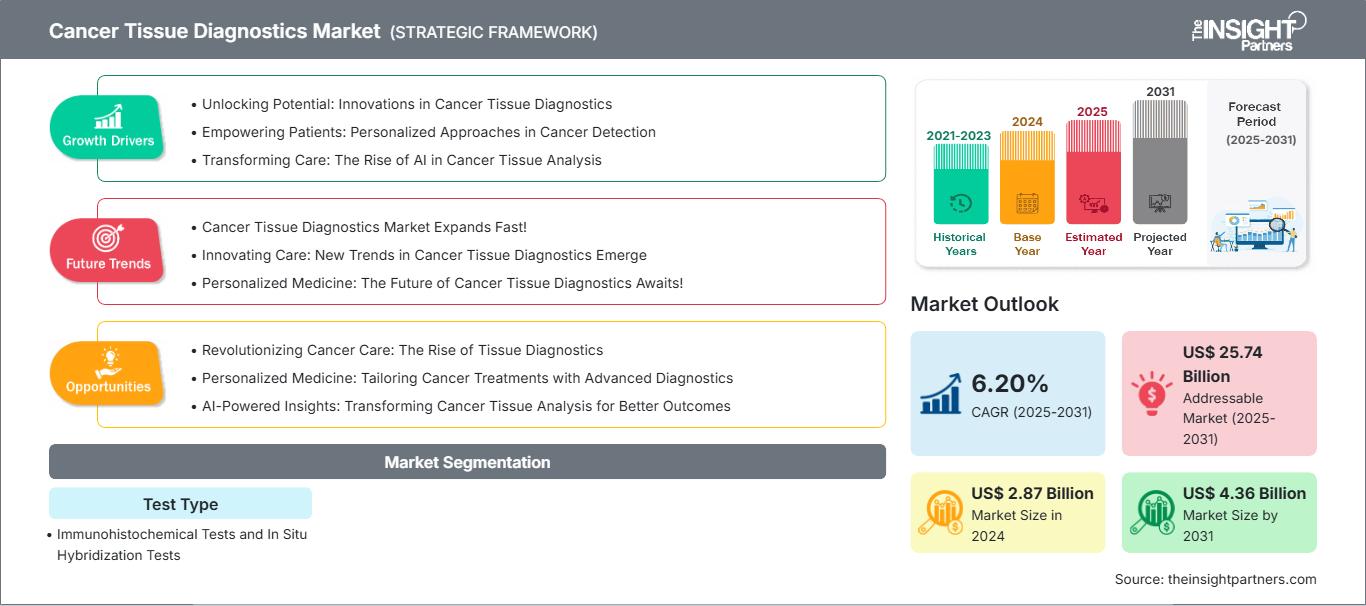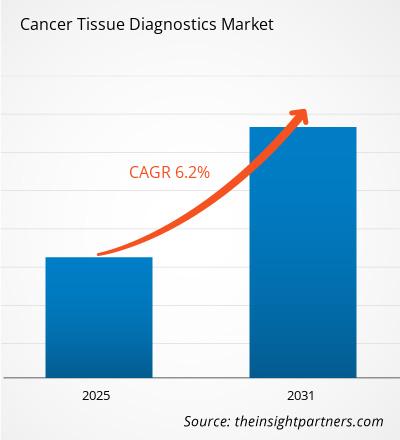Der Markt für Krebsgewebediagnostik soll von 2.538,31 Millionen US-Dollar im Jahr 2022 auf 3.640,87 Millionen US-Dollar im Jahr 2031 anwachsen; von 2022 bis 2031 wird ein durchschnittliches jährliches Wachstum von 6,2 % erwartet.
Krebsgewebediagnostikverfahren dienen der Tumorerkennung in bösartigem Gewebe. In den letzten Jahren wurde die Immunhistochemie (IHC) eingesetzt, um die Erkennung spezifischer Antigene in Tumorgewebe zu verbessern. Mithilfe nichtfluoreszierender Chromogene wird das Screening mit konventioneller Mikroskopie analysiert. Es gibt neue Verfahren zur Krebsgewebediagnostik. Fluoreszenz-in-situ-Hybridisierung wird zur Untersuchung genetischer Anomalien im Genom eingesetzt. Die hybridisierte Desoxyribonukleinsäure (DNA) wird mit speziellen Sonden untersucht.
Der Markt für Krebsgewebediagnostik ist nach Testtyp und Geografie segmentiert. Basierend auf dem Testtyp wird der Markt in immunhistochemische Tests und In-situ-Hybridisierungstests unterteilt. Im Jahr 2022 hatte das Segment der immunhistochemischen Tests einen größeren Marktanteil. Es wird auch erwartet, dass der Markt in diesem Segment in den kommenden Jahren schneller wachsen wird. Geografisch ist der Markt für Krebsgewebediagnostik grob in Nordamerika, Europa, den asiatisch-pazifischen Raum, den Nahen Osten und Afrika sowie Süd- und Mittelamerika segmentiert. Der Markt im asiatisch-pazifischen Raum wird im Prognosezeitraum aufgrund der steigenden Krebsprävalenz und der zunehmenden Alterung der Bevölkerung in asiatischen Ländern voraussichtlich am stärksten wachsen. Die japanische Regierung hat zahlreiche Initiativen und Programme formuliert und umgesetzt, um die Qualität der Krebsbehandlung zu verbessern und das Bewusstsein für Krebs im Land zu schärfen. In China wurden laut WHO-Daten im Jahr 2021 45.68.754 neue Krebsfälle festgestellt und 30.02.899 Krebstodesfälle verzeichnet. Der Bericht zur Krebsgewebediagnostik bietet Einblicke und eine eingehende Analyse des Marktes und hebt Parameter wie Markttrends, technologische Fortschritte, Marktdynamik und die Wettbewerbsanalyse der weltweit führenden Marktteilnehmer hervor.
Passen Sie diesen Bericht Ihren Anforderungen an
Sie erhalten kostenlos Anpassungen an jedem Bericht, einschließlich Teilen dieses Berichts oder einer Analyse auf Länderebene, eines Excel-Datenpakets sowie tolle Angebote und Rabatte für Start-ups und Universitäten.
Markt für Krebsgewebediagnostik: Strategische Einblicke

-
Holen Sie sich die wichtigsten Markttrends aus diesem Bericht.Dieses KOSTENLOSE Beispiel umfasst Datenanalysen, die von Markttrends bis hin zu Schätzungen und Prognosen reichen.
Markteinblicke
Neue Produkteinführungen und FDA-Zulassungen sowie steigende Investitionen in die Krebsgewebediagnostik beflügeln den Markt für Krebsgewebediagnostik im Prognosezeitraum
Die meisten großen Marktteilnehmer stellen eine breite Palette von Krebsdiagnostikprodukten her, die maximale Vorteile und eine frühzeitige Diagnose bieten. Im Juni 2022 kündigte Roche die Einführung des BenchMark ULTRA PLUS-Systems an, seiner neuesten fortschrittlichen Gewebefärbeplattform. Das System ermöglicht schnelle und genaue Testergebnisse, sodass Ärzte rechtzeitig Entscheidungen bezüglich des Behandlungsverlaufs eines Patienten treffen können.
Im März 2022 brachte Illumina in Europa einen neuen In-vitro-Diagnosetest auf den Markt, der verschiedene Krebsmutationen profilieren und Patienten zielgerichtete Therapien empfehlen soll. Die ständigen technologischen Entwicklungen in der Diagnostik und die FDA-Zulassungen beschleunigen somit das Marktwachstum.
Darüber hinaus ist die Gewebediagnostik für die Krebsbehandlung von entscheidender Bedeutung. Die Krebsgewebediagnostik spielt eine wichtige Rolle bei der Bestimmung des Behandlungstempos und -ablaufs. Früherkennung kann dazu beitragen, die Sterblichkeitsrate von Krebs zu senken. Daher implementieren medizinische Fachkräfte, Marktteilnehmer und Regierungsbehörden neue Diagnose- und Behandlungsmöglichkeiten. Steigende Investitionen und bessere Erstattungsrichtlinien begünstigen somit das Wachstum des Marktes für Krebsgewebediagnostik.
Im Mai 2021 hat QIAGEN NV einen erweiterten Geltungsbereich von Companion Diagnostics (CDx)-Ansprüchen für das therascreen KRAS RGQ PCR Kit (therascreen KRAS Kit) eingeführt, nachdem es die US-amerikanische Zulassung als Companion Diagnostic zur Unterstützung der Identifizierung von Patienten mit nicht-kleinzelligem Lungenkrebs (NSCLC) erhalten hatte, die möglicherweise für eine Behandlung mit LUMAKRASTM (Sotorasib) in Frage kommen, einer neu zugelassenen Therapie, die von Amgen Inc. (AMGN) entwickelt und vermarktet wird. Darüber hinaus haben Illumina und Roche im Januar 2021 eine 15-jährige, nicht exklusive Kooperationsvereinbarung unterzeichnet, die das Potenzial von NGS zur Transformation der Krebsrisikovorhersage, -erkennung, -diagnose, -behandlung und -überwachung ausschöpfen soll. Der Wert der Partnerschaft, die Initiativen zur In-vitro-Diagnostik (IVD) und Begleitdiagnostik (CDx) umfasst, wurde nicht bekannt gegeben. Im Jahr 2021 führte das Unternehmen die Cloud-Plattform AIforia ein, die die Bildverarbeitung beschleunigt und eine automatisierte pathologische Bildanalyse ermöglicht. Die zunehmende Zusammenarbeit und die neuen technologischen Plattformen in der Krebsgewebediagnostik haben somit zur Entwicklung bahnbrechender Techniken geführt, die das Marktwachstum in den kommenden Jahren vorantreiben dürften.
Testtyp-Einblicke
Basierend auf dem Testtyp ist der Markt für Krebsgewebediagnostik in immunhistochemische Tests und In-situ-Hybridisierungstests unterteilt. Im Jahr 2022 hatte das Segment der immunhistochemischen Tests einen größeren Marktanteil. Darüber hinaus wird erwartet, dass der Markt in diesem Segment in den kommenden Jahren aufgrund der Kosteneffizienz der Technik schneller wachsen wird. Darüber hinaus ist die Technik leicht zugänglich, und es wird erwartet, dass die wachsende Anzahl technologiebasierter Produkte das Segmentwachstum weiter vorantreiben wird.
Produkteinführungen und Kooperationen sind bei den Akteuren des globalen Marktes für Krebsgewebediagnostik weit verbreitete Strategien. Einige der jüngsten wichtigen Marktentwicklungen sind nachstehend aufgeführt:
- Im Juni 2022 kündigte Roche die Einführung des BenchMark ULTRA PLUS-Systems an, seiner neuesten fortschrittlichen Plattform zur Gewebefärbung. Das System ermöglicht schnelle und genaue Testergebnisse, sodass Ärzte zeitnahe Entscheidungen bezüglich des Behandlungsverlaufs eines Patienten treffen können.
- Im März 2022 brachte Illumina in Europa einen neuen In-vitro-Diagnosetest auf den Markt, der verschiedene Krebsmutationen profilieren und Patienten zielgerichtete Therapien empfehlen soll.
- Im Mai 2021 führte QIAGEN NV einen erweiterten Anwendungsbereich für Begleitdiagnostika (CDx) für das therascreen KRAS RGQ PCR Kit (therascreen KRAS Kit) ein, nachdem es in den USA die behördliche Zulassung als Begleitdiagnostikum zur Unterstützung der Identifizierung von Patienten mit nicht-kleinzelligem Lungenkrebs (NSCLC) erhalten hatte, die möglicherweise für eine Behandlung mit LUMAKRASTM (Sotorasib) in Frage kommen, einer neu zugelassenen Therapie, die von Amgen Inc. (AMGN) entwickelt und vermarktet wird.
- Im Januar 2021 unterzeichneten Illumina und Roche eine 15-jährige, nicht-exklusive Kooperationsvereinbarung, die das Potenzial von NGS zur Transformation der Krebsrisikovorhersage, -erkennung, -diagnose, -behandlung und -überwachung ausschöpfen soll. Der Wert der Partnerschaft, die Initiativen zur In-vitro-Diagnostik (IVD) und Begleitdiagnostik (CDx) umfasst, wurde nicht bekannt gegeben.
- Im Juni 2021 erhielt Agilent Technologies Inc. die Zulassung der US-amerikanischen Food and Drug Administration (FDA) für seinen PD-L1 IHC 22C3 pharmDx-Test. Der Test ist zur Identifizierung von Patienten mit Plattenepithelkarzinomen im Kopf-Hals-Bereich (HNSCC) für die Behandlung mit KEYTRUDA (Pembrolizumab), einem Anti-PD-1-Präparat von Merck, zugelassen.
- Im Juni 2021 erhielt der Oncomine Dx Target Test von Thermo Fisher Scientific die Kostenerstattung vom japanischen Ministerium für Gesundheit, Arbeit und Soziales. Der Test ist jetzt in Japan im Handel erhältlich. Die Kostenerstattung hat dem Unternehmen geholfen, die Diagnose von NSCLC anzubieten.\
- Im Mai 2021 brachte Roche den VENTANA ROS1 (SP384) Rabbit Monoclonal Primary Antibody auf den Markt, einen in vitro diagnostischen ROS1-Immunhistochemietest (IHC). Die Markteinführung hat es dem Unternehmen ermöglicht, bessere innovative Produkte anzubieten.
Firmenprofile
- F. Hoffmann-La Roche Ltd
- Thermo Fisher Scientific Inc
- Bio Rad Laboratories Inc
- Abbott
- Enzo Life Sciences, Inc
- Agilent Technologies, Inc
- Cancer Genetics Inc
- Merck KGaA (Sigma-Aldrich Co. LLC)
- Danaher Corporation
- Abcam plc.
Regionale Einblicke in den Markt für Krebsgewebediagnostik
Die Analysten von The Insight Partners haben die regionalen Trends und Faktoren, die den Markt für Krebsgewebediagnostik im Prognosezeitraum beeinflussen, ausführlich erläutert. In diesem Abschnitt werden auch die Marktsegmente und die geografische Lage in Nordamerika, Europa, dem asiatisch-pazifischen Raum, dem Nahen Osten und Afrika sowie Süd- und Mittelamerika erörtert.
Umfang des Marktberichts zur Krebsgewebediagnostik
| Berichtsattribut | Einzelheiten |
|---|---|
| Marktgröße in 2024 | US$ 2.87 Billion |
| Marktgröße nach 2031 | US$ 4.36 Billion |
| Globale CAGR (2025 - 2031) | 6.20% |
| Historische Daten | 2021-2023 |
| Prognosezeitraum | 2025-2031 |
| Abgedeckte Segmente |
By Testtyp
|
| Abgedeckte Regionen und Länder |
Nordamerika
|
| Marktführer und wichtige Unternehmensprofile |
|
Dichte der Marktteilnehmer im Bereich der Krebsgewebediagnostik: Verständnis ihrer Auswirkungen auf die Geschäftsdynamik
Der Markt für Krebsgewebediagnostik wächst rasant. Die steigende Nachfrage der Endverbraucher ist auf Faktoren wie veränderte Verbraucherpräferenzen, technologische Fortschritte und ein stärkeres Bewusstsein für die Produktvorteile zurückzuführen. Mit der steigenden Nachfrage erweitern Unternehmen ihr Angebot, entwickeln Innovationen, um den Bedürfnissen der Verbraucher gerecht zu werden, und nutzen neue Trends, was das Marktwachstum weiter ankurbelt.

- Holen Sie sich die Markt für Krebsgewebediagnostik Übersicht der wichtigsten Akteure
- Historische Analyse (2 Jahre), Basisjahr, Prognose (7 Jahre) mit CAGR
- PEST- und SWOT-Analyse
- Marktgröße Wert/Volumen – Global, Regional, Land
- Branchen- und Wettbewerbslandschaft
- Excel-Datensatz
Aktuelle Berichte
Verwandte Berichte
Erfahrungsberichte
Grund zum Kauf
- Fundierte Entscheidungsfindung
- Marktdynamik verstehen
- Wettbewerbsanalyse
- Kundeneinblicke
- Marktprognosen
- Risikominimierung
- Strategische Planung
- Investitionsbegründung
- Identifizierung neuer Märkte
- Verbesserung von Marketingstrategien
- Steigerung der Betriebseffizienz
- Anpassung an regulatorische Trends






















 Kostenlose Probe anfordern für - Markt für Krebsgewebediagnostik
Kostenlose Probe anfordern für - Markt für Krebsgewebediagnostik